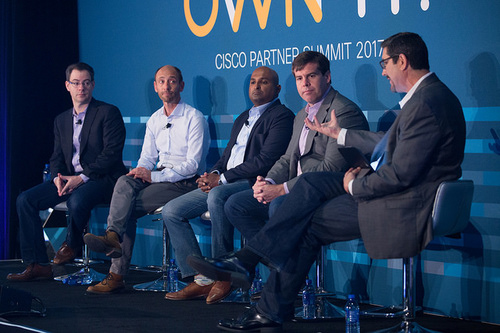Cisco: we’ll put IT back in charge
Cisco and its partners want to put IT back in charge of their enterprise technology infrastructure, reports Enterprise Cloud News (Banking Technology’s sister publication).
Years of deploying technology in multiple locations have left enterprise IT with cloud sprawl, workloads spread over multiple public, private and hybrid clouds. By applying the right technology and business services, Cisco and its partners are looking to help IT bring all that under control.
“We’re putting IT back in control as the cloud broker for their enterprise departments,” Scott Mohr, Cisco director, data centre and cloud global partner organisation solutions, architecture, engineering, said at the Cisco Partner Summit. “These services put IT departments back in the driver’s seat.”
Several years ago, the problem was “shadow IT” – individuals and departments setting up their own cloud services without IT approval, such as the sales department signing up on its own for Salesforce, or developers signing on to Amazon Web Services (AWS) for dev/test. Now, enterprises are looking to move out of their data centre, says Vinu Thomas, CTO for Cisco partner Presidio.
“Enterprises come to us wanting to come off the data centre and go ‘all in’ to the cloud,” Thomas says. Presidio helps enterprises identify their key business drivers, application infrastructure, people, and business processes. They look at reasons for going to the cloud, existing infrastructure and where they are already invested in the cloud, and then provide a framework for cloud migration.
“For the enterprise, it’s a six- to nine-month engagement to get them to the endpoint of being truly multicloud,” Thomas says.
Some enterprises look to a “big bang” approach, with a comprehensive migration of their entire infrastructure. Others move one piece at a time. Interestingly, the process turns out to be the same, says Jim Fagan, head of global platforms for Australian service provider Telstra.
“When we get these big, visionary RFPs, that’s a long sales cycle, but how we get to the outcome, it’s the same way as getting incrementally there,” Fagan explains. That means identifying individual applications and use cases and developing a cloud strategy. “The big bang doesn’t go quickly,” he adds.
Andy Fleck, head of cloud management for Cisco partner Engage, works with UK central government agencies, and finds those organisations have special problems. The UK government has a “cloud first” strategy, but has realised that’s not always simple. Agencies have stringent rules they need to follow for IT, and local government has old data centre infrastructure that is challenging to migrate.
“Now we’re seeing people switch from ‘cloud first’ to ‘cloud right,'” Fagan says. Enterprises have already migrated workloads to the cloud and now need to optimise the job. “They’re not sure they did that properly,” he says.
Kip Compton, Cisco VP, cloud platform and solutions group, says one Fortune 50 CIO told him over lunch that the cloud doesn’t simplify her job. “I don’t have to run the air conditioner or the power, but all the other parts of the job are still there,” she stated. These include security, compliance, working with users, controlling costs, and more.
Cisco’s own proliferating product line has contributed to the complexity, Compton confesses. To that end, Cisco this week says it is consolidating its cloud offerings into four packages in the Cisco Multicloud Portfolio: Cloud Advisory, for planning and design; Cloud Connect, for connecting enterprise private networks to the public cloud; Cloud Protect, for security; and Cloud Consume, for deploying, monitoring, and optimising applications.











































